Business Strategy for Marks and Spencer
VerifiedAdded on 2023/06/18
|17
|5159
|110
AI Summary
This report analyses the impact of macro and micro environment on Marks and Spencer's business strategy. It also evaluates the internal environment and capabilities of the company using SWOT and VRIO analysis. The competitive forces of the retail industry are evaluated using Porter's Five Forces model.
Contribute Materials
Your contribution can guide someone’s learning journey. Share your
documents today.
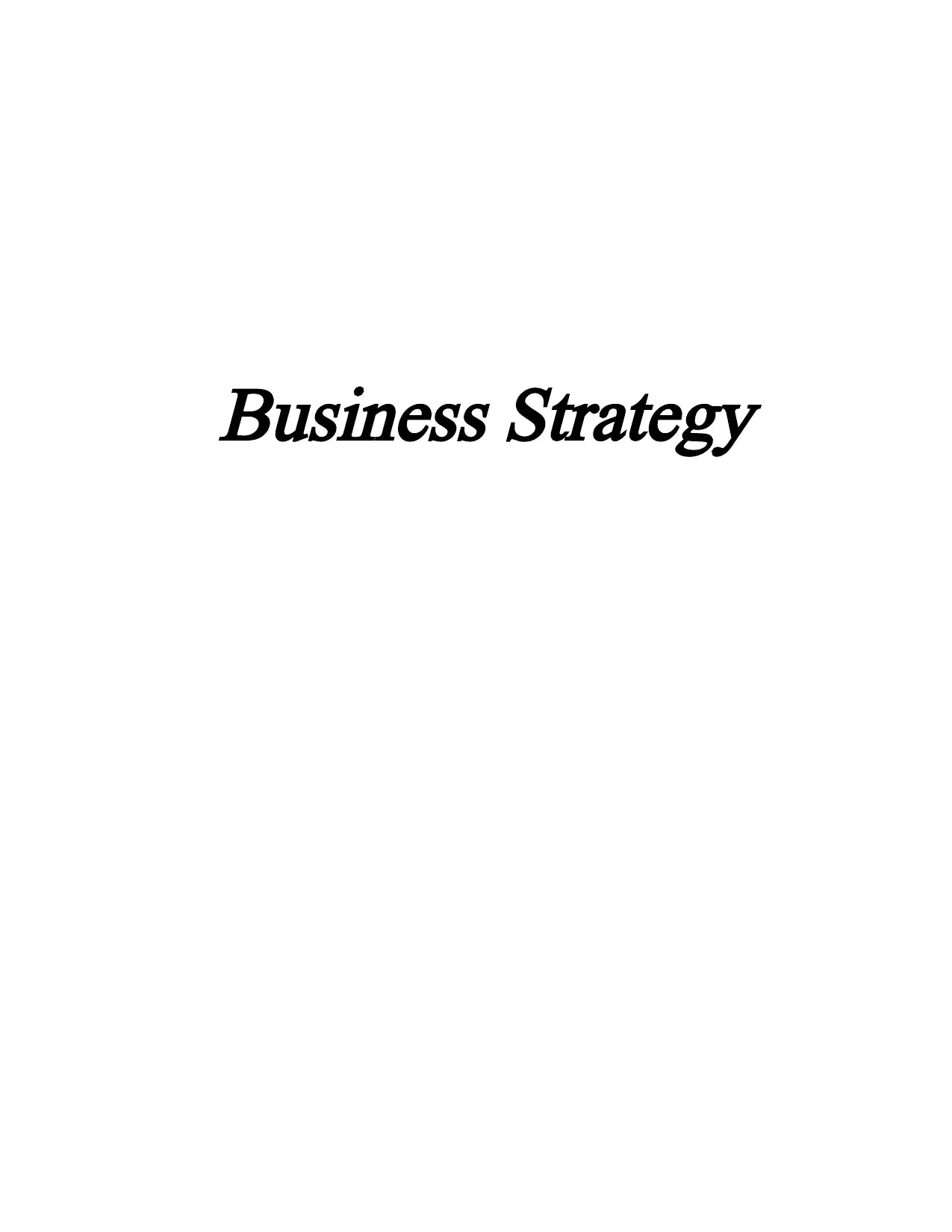
Business Strategy
Secure Best Marks with AI Grader
Need help grading? Try our AI Grader for instant feedback on your assignments.
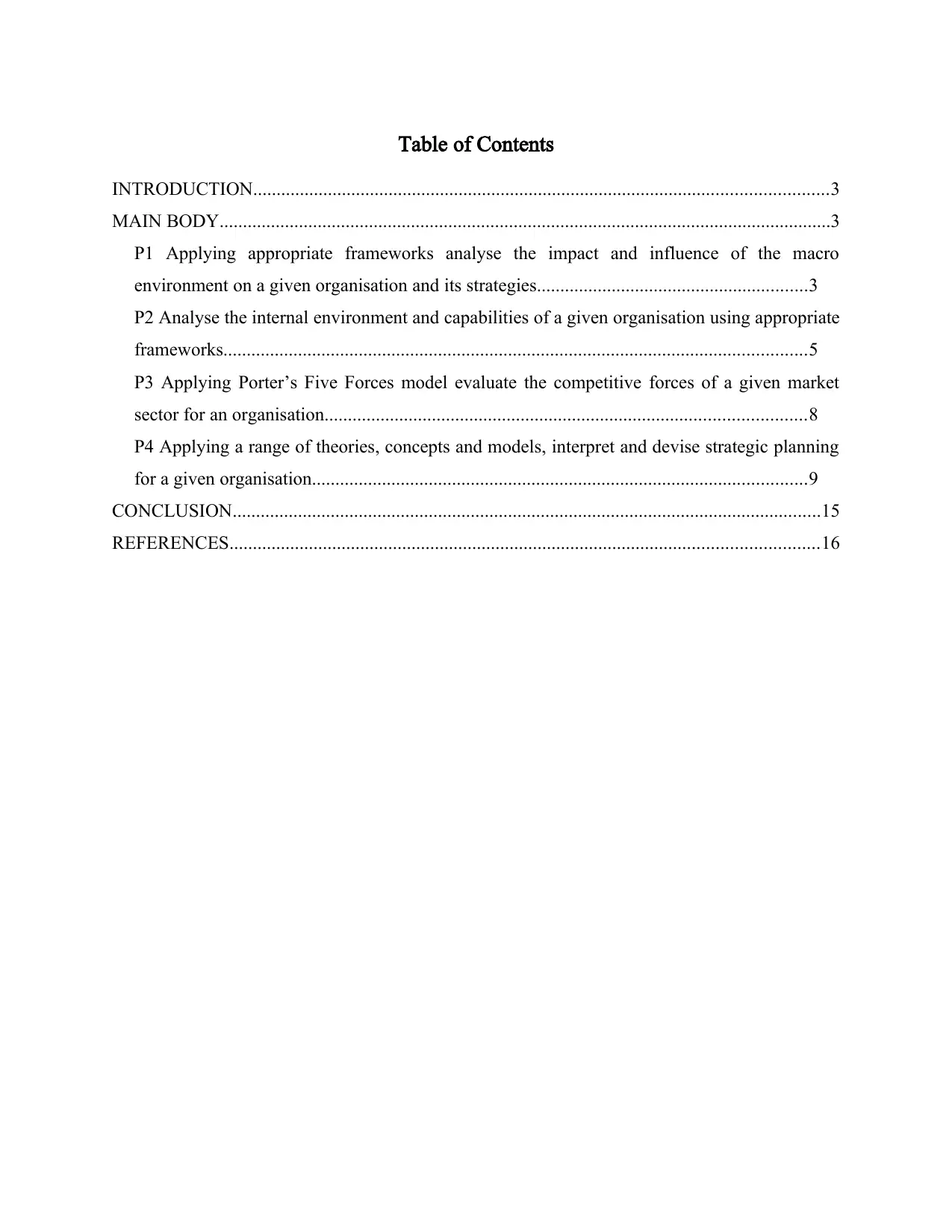
Table of Contents
INTRODUCTION...........................................................................................................................3
MAIN BODY...................................................................................................................................3
P1 Applying appropriate frameworks analyse the impact and influence of the macro
environment on a given organisation and its strategies..........................................................3
P2 Analyse the internal environment and capabilities of a given organisation using appropriate
frameworks.............................................................................................................................5
P3 Applying Porter’s Five Forces model evaluate the competitive forces of a given market
sector for an organisation.......................................................................................................8
P4 Applying a range of theories, concepts and models, interpret and devise strategic planning
for a given organisation..........................................................................................................9
CONCLUSION..............................................................................................................................15
REFERENCES..............................................................................................................................16
INTRODUCTION...........................................................................................................................3
MAIN BODY...................................................................................................................................3
P1 Applying appropriate frameworks analyse the impact and influence of the macro
environment on a given organisation and its strategies..........................................................3
P2 Analyse the internal environment and capabilities of a given organisation using appropriate
frameworks.............................................................................................................................5
P3 Applying Porter’s Five Forces model evaluate the competitive forces of a given market
sector for an organisation.......................................................................................................8
P4 Applying a range of theories, concepts and models, interpret and devise strategic planning
for a given organisation..........................................................................................................9
CONCLUSION..............................................................................................................................15
REFERENCES..............................................................................................................................16
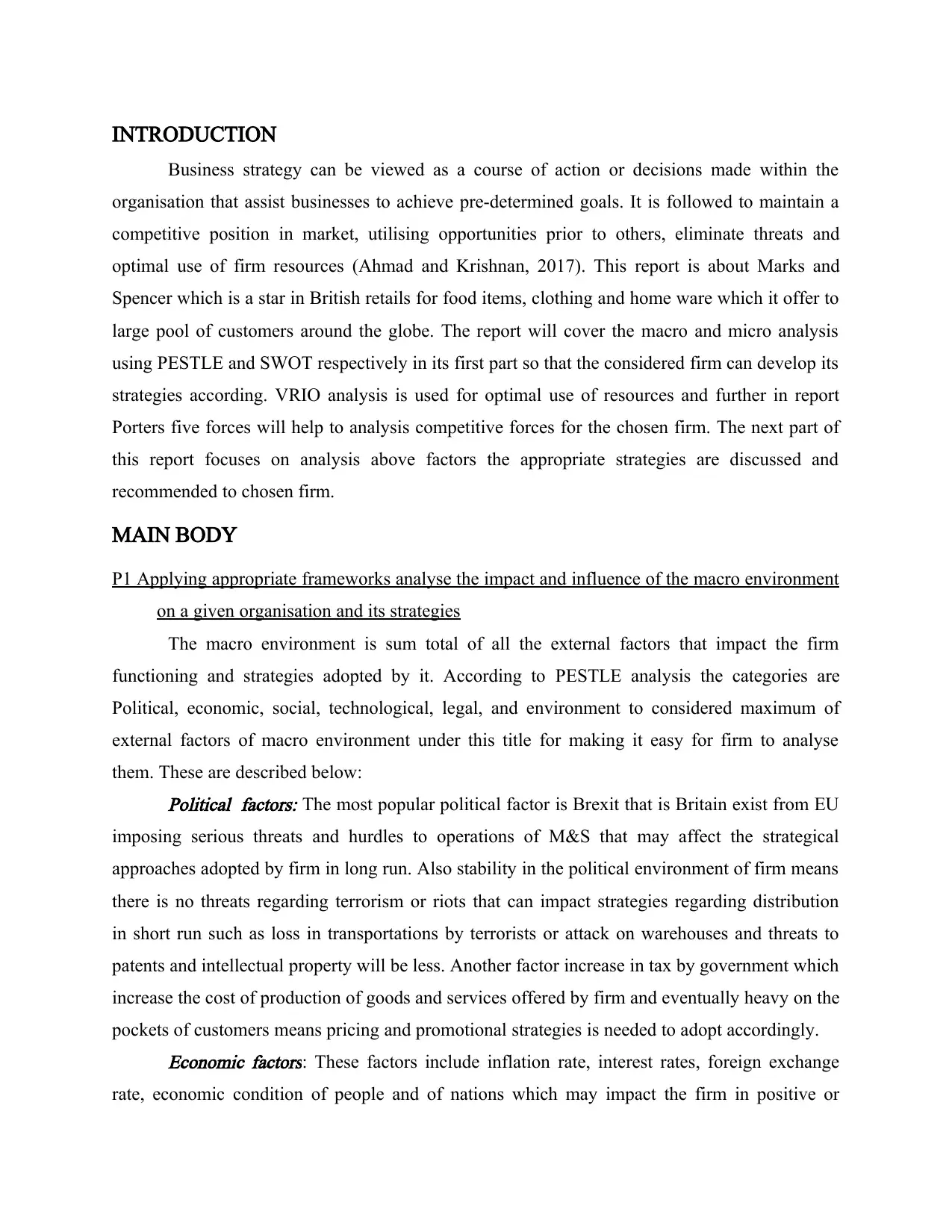
INTRODUCTION
Business strategy can be viewed as a course of action or decisions made within the
organisation that assist businesses to achieve pre-determined goals. It is followed to maintain a
competitive position in market, utilising opportunities prior to others, eliminate threats and
optimal use of firm resources (Ahmad and Krishnan, 2017). This report is about Marks and
Spencer which is a star in British retails for food items, clothing and home ware which it offer to
large pool of customers around the globe. The report will cover the macro and micro analysis
using PESTLE and SWOT respectively in its first part so that the considered firm can develop its
strategies according. VRIO analysis is used for optimal use of resources and further in report
Porters five forces will help to analysis competitive forces for the chosen firm. The next part of
this report focuses on analysis above factors the appropriate strategies are discussed and
recommended to chosen firm.
MAIN BODY
P1 Applying appropriate frameworks analyse the impact and influence of the macro environment
on a given organisation and its strategies
The macro environment is sum total of all the external factors that impact the firm
functioning and strategies adopted by it. According to PESTLE analysis the categories are
Political, economic, social, technological, legal, and environment to considered maximum of
external factors of macro environment under this title for making it easy for firm to analyse
them. These are described below:
Political factors: The most popular political factor is Brexit that is Britain exist from EU
imposing serious threats and hurdles to operations of M&S that may affect the strategical
approaches adopted by firm in long run. Also stability in the political environment of firm means
there is no threats regarding terrorism or riots that can impact strategies regarding distribution
in short run such as loss in transportations by terrorists or attack on warehouses and threats to
patents and intellectual property will be less. Another factor increase in tax by government which
increase the cost of production of goods and services offered by firm and eventually heavy on the
pockets of customers means pricing and promotional strategies is needed to adopt accordingly.
Economic factors: These factors include inflation rate, interest rates, foreign exchange
rate, economic condition of people and of nations which may impact the firm in positive or
Business strategy can be viewed as a course of action or decisions made within the
organisation that assist businesses to achieve pre-determined goals. It is followed to maintain a
competitive position in market, utilising opportunities prior to others, eliminate threats and
optimal use of firm resources (Ahmad and Krishnan, 2017). This report is about Marks and
Spencer which is a star in British retails for food items, clothing and home ware which it offer to
large pool of customers around the globe. The report will cover the macro and micro analysis
using PESTLE and SWOT respectively in its first part so that the considered firm can develop its
strategies according. VRIO analysis is used for optimal use of resources and further in report
Porters five forces will help to analysis competitive forces for the chosen firm. The next part of
this report focuses on analysis above factors the appropriate strategies are discussed and
recommended to chosen firm.
MAIN BODY
P1 Applying appropriate frameworks analyse the impact and influence of the macro environment
on a given organisation and its strategies
The macro environment is sum total of all the external factors that impact the firm
functioning and strategies adopted by it. According to PESTLE analysis the categories are
Political, economic, social, technological, legal, and environment to considered maximum of
external factors of macro environment under this title for making it easy for firm to analyse
them. These are described below:
Political factors: The most popular political factor is Brexit that is Britain exist from EU
imposing serious threats and hurdles to operations of M&S that may affect the strategical
approaches adopted by firm in long run. Also stability in the political environment of firm means
there is no threats regarding terrorism or riots that can impact strategies regarding distribution
in short run such as loss in transportations by terrorists or attack on warehouses and threats to
patents and intellectual property will be less. Another factor increase in tax by government which
increase the cost of production of goods and services offered by firm and eventually heavy on the
pockets of customers means pricing and promotional strategies is needed to adopt accordingly.
Economic factors: These factors include inflation rate, interest rates, foreign exchange
rate, economic condition of people and of nations which may impact the firm in positive or
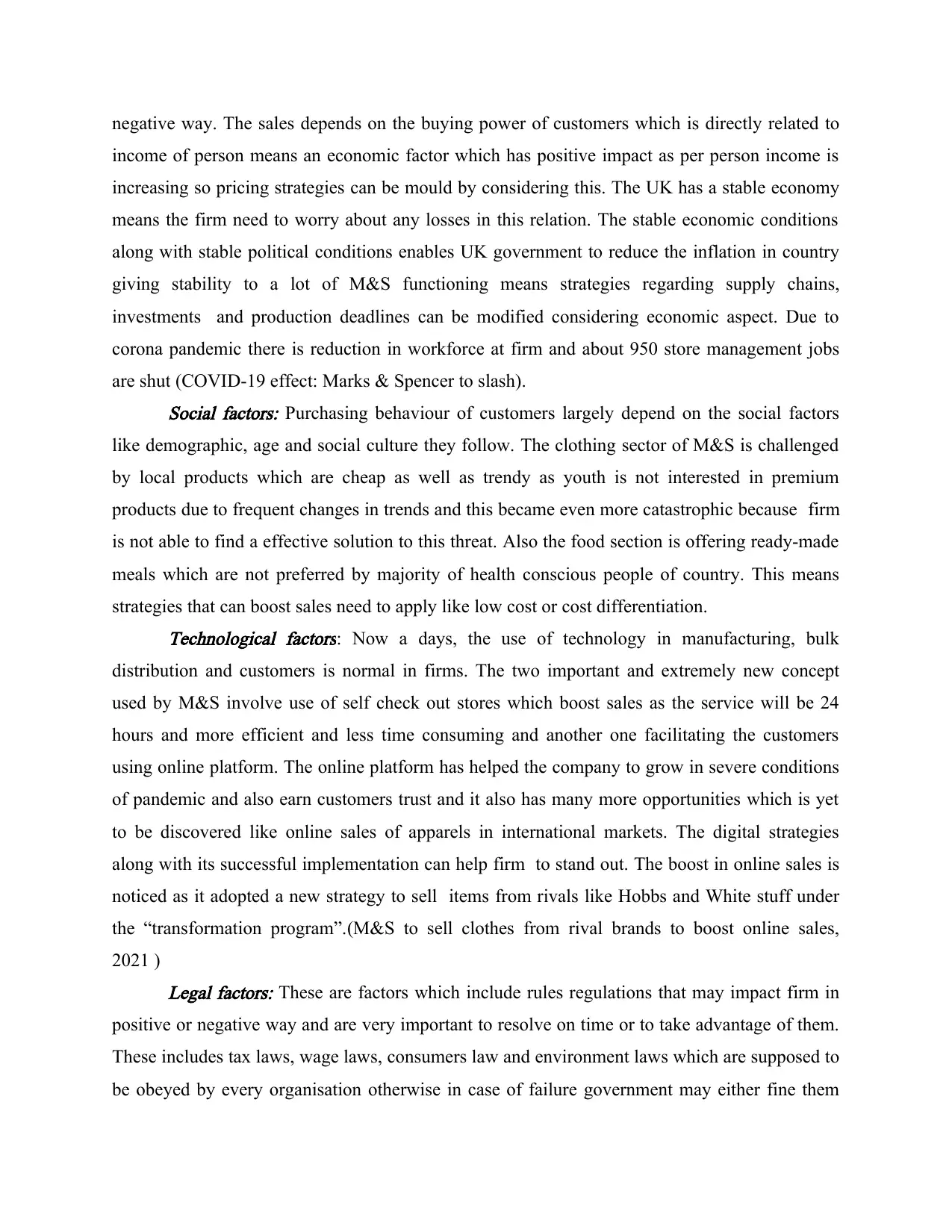
negative way. The sales depends on the buying power of customers which is directly related to
income of person means an economic factor which has positive impact as per person income is
increasing so pricing strategies can be mould by considering this. The UK has a stable economy
means the firm need to worry about any losses in this relation. The stable economic conditions
along with stable political conditions enables UK government to reduce the inflation in country
giving stability to a lot of M&S functioning means strategies regarding supply chains,
investments and production deadlines can be modified considering economic aspect. Due to
corona pandemic there is reduction in workforce at firm and about 950 store management jobs
are shut (COVID-19 effect: Marks & Spencer to slash).
Social factors: Purchasing behaviour of customers largely depend on the social factors
like demographic, age and social culture they follow. The clothing sector of M&S is challenged
by local products which are cheap as well as trendy as youth is not interested in premium
products due to frequent changes in trends and this became even more catastrophic because firm
is not able to find a effective solution to this threat. Also the food section is offering ready-made
meals which are not preferred by majority of health conscious people of country. This means
strategies that can boost sales need to apply like low cost or cost differentiation.
Technological factors: Now a days, the use of technology in manufacturing, bulk
distribution and customers is normal in firms. The two important and extremely new concept
used by M&S involve use of self check out stores which boost sales as the service will be 24
hours and more efficient and less time consuming and another one facilitating the customers
using online platform. The online platform has helped the company to grow in severe conditions
of pandemic and also earn customers trust and it also has many more opportunities which is yet
to be discovered like online sales of apparels in international markets. The digital strategies
along with its successful implementation can help firm to stand out. The boost in online sales is
noticed as it adopted a new strategy to sell items from rivals like Hobbs and White stuff under
the “transformation program”.(M&S to sell clothes from rival brands to boost online sales,
2021 ) Legal factors: These are factors which include rules regulations that may impact firm in
positive or negative way and are very important to resolve on time or to take advantage of them.
These includes tax laws, wage laws, consumers law and environment laws which are supposed to
be obeyed by every organisation otherwise in case of failure government may either fine them
income of person means an economic factor which has positive impact as per person income is
increasing so pricing strategies can be mould by considering this. The UK has a stable economy
means the firm need to worry about any losses in this relation. The stable economic conditions
along with stable political conditions enables UK government to reduce the inflation in country
giving stability to a lot of M&S functioning means strategies regarding supply chains,
investments and production deadlines can be modified considering economic aspect. Due to
corona pandemic there is reduction in workforce at firm and about 950 store management jobs
are shut (COVID-19 effect: Marks & Spencer to slash).
Social factors: Purchasing behaviour of customers largely depend on the social factors
like demographic, age and social culture they follow. The clothing sector of M&S is challenged
by local products which are cheap as well as trendy as youth is not interested in premium
products due to frequent changes in trends and this became even more catastrophic because firm
is not able to find a effective solution to this threat. Also the food section is offering ready-made
meals which are not preferred by majority of health conscious people of country. This means
strategies that can boost sales need to apply like low cost or cost differentiation.
Technological factors: Now a days, the use of technology in manufacturing, bulk
distribution and customers is normal in firms. The two important and extremely new concept
used by M&S involve use of self check out stores which boost sales as the service will be 24
hours and more efficient and less time consuming and another one facilitating the customers
using online platform. The online platform has helped the company to grow in severe conditions
of pandemic and also earn customers trust and it also has many more opportunities which is yet
to be discovered like online sales of apparels in international markets. The digital strategies
along with its successful implementation can help firm to stand out. The boost in online sales is
noticed as it adopted a new strategy to sell items from rivals like Hobbs and White stuff under
the “transformation program”.(M&S to sell clothes from rival brands to boost online sales,
2021 ) Legal factors: These are factors which include rules regulations that may impact firm in
positive or negative way and are very important to resolve on time or to take advantage of them.
These includes tax laws, wage laws, consumers law and environment laws which are supposed to
be obeyed by every organisation otherwise in case of failure government may either fine them
Secure Best Marks with AI Grader
Need help grading? Try our AI Grader for instant feedback on your assignments.

heavily or cease their operations. M&S pay its full attention so that any chances of failure to
follow the regulations imposed by local or state government but still one situations has arrived in
which company is fined by government under Health and Safety at Work act 1974 for not
establishing norms towards safety of workers. The legal department can adopt certain legal
strategies according to situation to save themselves from punishments and fines.
Environmental factors: Traditionally climate is only factors that impact firms functioning
but due to industrialisation the firms are now posing a big threat to environment. To deal with
this strategies must mould perception of storage and enhanced transportation. As more and more
people are aware of environmental they look for strategies which follow sustainable practices in
production and distributions. So, the firms like M&S which are internationally recognised is
under the pressure to follow environmental laws defined by government and also independently
focus on sustainable produce to gain customer trust.
The above discussed factors which may act as an opportunity or threat depending on its
impact on chosen firm will help to establish strategies that will ensure success of firm in long
run. It also help to determine how to evolve strategies so that the competition with other firms
can be tackled.
P2 Analyse the internal environment and capabilities of a given organisation using appropriate
frameworks
When the external environment is analysed we need to adopt the some models for
analysis of internal environment study its internal factors that can affect firm performance. In
order to do so we are using SWOT and VRIO analysis so that firm can be stable from inside as
well. SWOT Analysis: In this analysis the internal factors are studied which help[ to formulate
that can work best for firm (Bourguignon and Floquet,2019). The factors are Strengths,
weaknesses, opportunities and threats and each of these is discussed below in tabular form:Strengths:
Weaknesses:
Brand image of M&S is strength which
is due to quality of product and service
they offer to its customers.
Global presence enables to expand its
Declining sales due to pandemic and
frequent change in trends.
High cost of production as the
manufacturing process is manual
follow the regulations imposed by local or state government but still one situations has arrived in
which company is fined by government under Health and Safety at Work act 1974 for not
establishing norms towards safety of workers. The legal department can adopt certain legal
strategies according to situation to save themselves from punishments and fines.
Environmental factors: Traditionally climate is only factors that impact firms functioning
but due to industrialisation the firms are now posing a big threat to environment. To deal with
this strategies must mould perception of storage and enhanced transportation. As more and more
people are aware of environmental they look for strategies which follow sustainable practices in
production and distributions. So, the firms like M&S which are internationally recognised is
under the pressure to follow environmental laws defined by government and also independently
focus on sustainable produce to gain customer trust.
The above discussed factors which may act as an opportunity or threat depending on its
impact on chosen firm will help to establish strategies that will ensure success of firm in long
run. It also help to determine how to evolve strategies so that the competition with other firms
can be tackled.
P2 Analyse the internal environment and capabilities of a given organisation using appropriate
frameworks
When the external environment is analysed we need to adopt the some models for
analysis of internal environment study its internal factors that can affect firm performance. In
order to do so we are using SWOT and VRIO analysis so that firm can be stable from inside as
well. SWOT Analysis: In this analysis the internal factors are studied which help[ to formulate
that can work best for firm (Bourguignon and Floquet,2019). The factors are Strengths,
weaknesses, opportunities and threats and each of these is discussed below in tabular form:Strengths:
Weaknesses:
Brand image of M&S is strength which
is due to quality of product and service
they offer to its customers.
Global presence enables to expand its
Declining sales due to pandemic and
frequent change in trends.
High cost of production as the
manufacturing process is manual
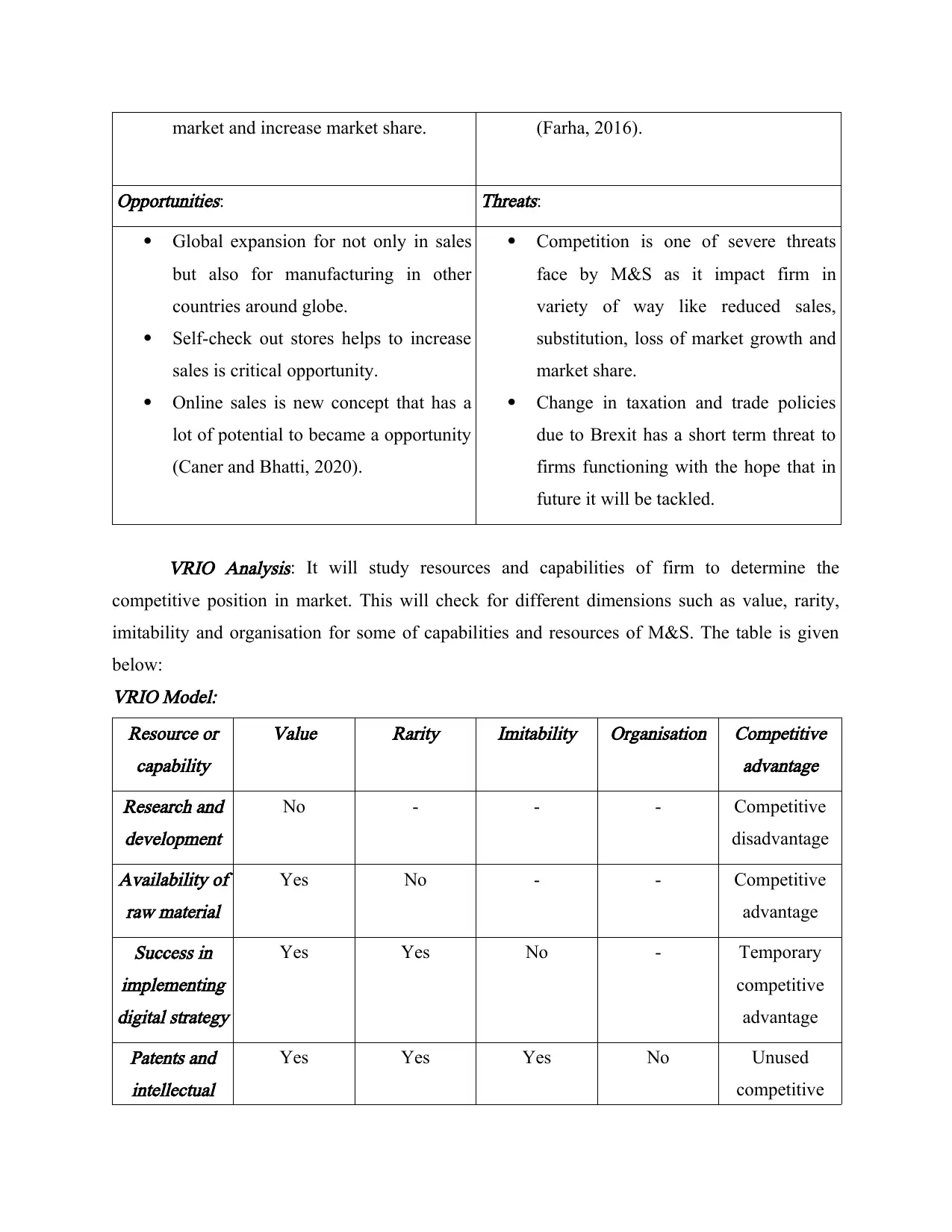
market and increase market share. (Farha, 2016).
Opportunities:
Threats:
Global expansion for not only in sales
but also for manufacturing in other
countries around globe.
Self-check out stores helps to increase
sales is critical opportunity.
Online sales is new concept that has a
lot of potential to became a opportunity
(Caner and Bhatti, 2020).
Competition is one of severe threats
face by M&S as it impact firm in
variety of way like reduced sales,
substitution, loss of market growth and
market share.
Change in taxation and trade policies
due to Brexit has a short term threat to
firms functioning with the hope that in
future it will be tackled.
VRIO Analysis: It will study resources and capabilities of firm to determine the
competitive position in market. This will check for different dimensions such as value, rarity,
imitability and organisation for some of capabilities and resources of M&S. The table is given
below:VRIO Model:
Resource or
capability
Value
Rarity Imitability Organisation Competitive
advantage
Research and
development
No - - - Competitive
disadvantageAvailability of
raw material
Yes No - - Competitive
advantageSuccess in
implementing
digital strategy
Yes Yes No - Temporary
competitive
advantagePatents and
intellectual
Yes Yes Yes No Unused
competitive
Opportunities:
Threats:
Global expansion for not only in sales
but also for manufacturing in other
countries around globe.
Self-check out stores helps to increase
sales is critical opportunity.
Online sales is new concept that has a
lot of potential to became a opportunity
(Caner and Bhatti, 2020).
Competition is one of severe threats
face by M&S as it impact firm in
variety of way like reduced sales,
substitution, loss of market growth and
market share.
Change in taxation and trade policies
due to Brexit has a short term threat to
firms functioning with the hope that in
future it will be tackled.
VRIO Analysis: It will study resources and capabilities of firm to determine the
competitive position in market. This will check for different dimensions such as value, rarity,
imitability and organisation for some of capabilities and resources of M&S. The table is given
below:VRIO Model:
Resource or
capability
Value
Rarity Imitability Organisation Competitive
advantage
Research and
development
No - - - Competitive
disadvantageAvailability of
raw material
Yes No - - Competitive
advantageSuccess in
implementing
digital strategy
Yes Yes No - Temporary
competitive
advantagePatents and
intellectual
Yes Yes Yes No Unused
competitive

property advantageFinancial
resources
Yes Yes Yes Yes Sustainable
competitive
advantage
Lets check the four dimension separately and analyse resources for getting chosen firms
position in market.
Value: From the table all are valuable except research and development as the expenses
on this by firm is not yielding positive output so it has competitive disadvantage for chosen firm.
Others are further checked for dimensions like rare, imitability and organisation to study their
competitive advantage (Gattorna,2017).
Rarity: Patents, financial resources and implementation of digital strategy are all rare
while availability of raw material is not rare thus has competitive advantage for firm. Patents ,
intellectual property and financial resources are checked in context to imitability and
organisation so that their competitive advantage can be analysed in next paragraph.
Imitability: Implementation of digital strategy has a risk of imitability as it can easily be
copied by viewing on websites which means this capability has temporary competition advantage
for M&S. Patents, intellectual property and financial resources are further checked whether they
are organised or not (Glauner, 2016).
Organisation: Patents and intellectual property of M&S are not organised because they
are not attended by firm but they has the potential for firm to use them for benefit of firm prior to
their expiry thus they can be termed as unused competitive advantage whereas financial
resources have sustainable competitive advantage as they are organised.BCG analysis:
BCG framework analysis product on two axes which are market share and market growth. BCG
Matrix has four categories according to which a company's products are classified
Stars-In this category the product with high growth market and high market share are
classified.
They are the top performing and star products of the company and they require a high
investment. Marks and Spencer's star is their clothing products as their maximum part of sale
comes from there. They offer a wide variety of clothing for men , women and children.
resources
Yes Yes Yes Yes Sustainable
competitive
advantage
Lets check the four dimension separately and analyse resources for getting chosen firms
position in market.
Value: From the table all are valuable except research and development as the expenses
on this by firm is not yielding positive output so it has competitive disadvantage for chosen firm.
Others are further checked for dimensions like rare, imitability and organisation to study their
competitive advantage (Gattorna,2017).
Rarity: Patents, financial resources and implementation of digital strategy are all rare
while availability of raw material is not rare thus has competitive advantage for firm. Patents ,
intellectual property and financial resources are checked in context to imitability and
organisation so that their competitive advantage can be analysed in next paragraph.
Imitability: Implementation of digital strategy has a risk of imitability as it can easily be
copied by viewing on websites which means this capability has temporary competition advantage
for M&S. Patents, intellectual property and financial resources are further checked whether they
are organised or not (Glauner, 2016).
Organisation: Patents and intellectual property of M&S are not organised because they
are not attended by firm but they has the potential for firm to use them for benefit of firm prior to
their expiry thus they can be termed as unused competitive advantage whereas financial
resources have sustainable competitive advantage as they are organised.BCG analysis:
BCG framework analysis product on two axes which are market share and market growth. BCG
Matrix has four categories according to which a company's products are classified
Stars-In this category the product with high growth market and high market share are
classified.
They are the top performing and star products of the company and they require a high
investment. Marks and Spencer's star is their clothing products as their maximum part of sale
comes from there. They offer a wide variety of clothing for men , women and children.
Paraphrase This Document
Need a fresh take? Get an instant paraphrase of this document with our AI Paraphraser
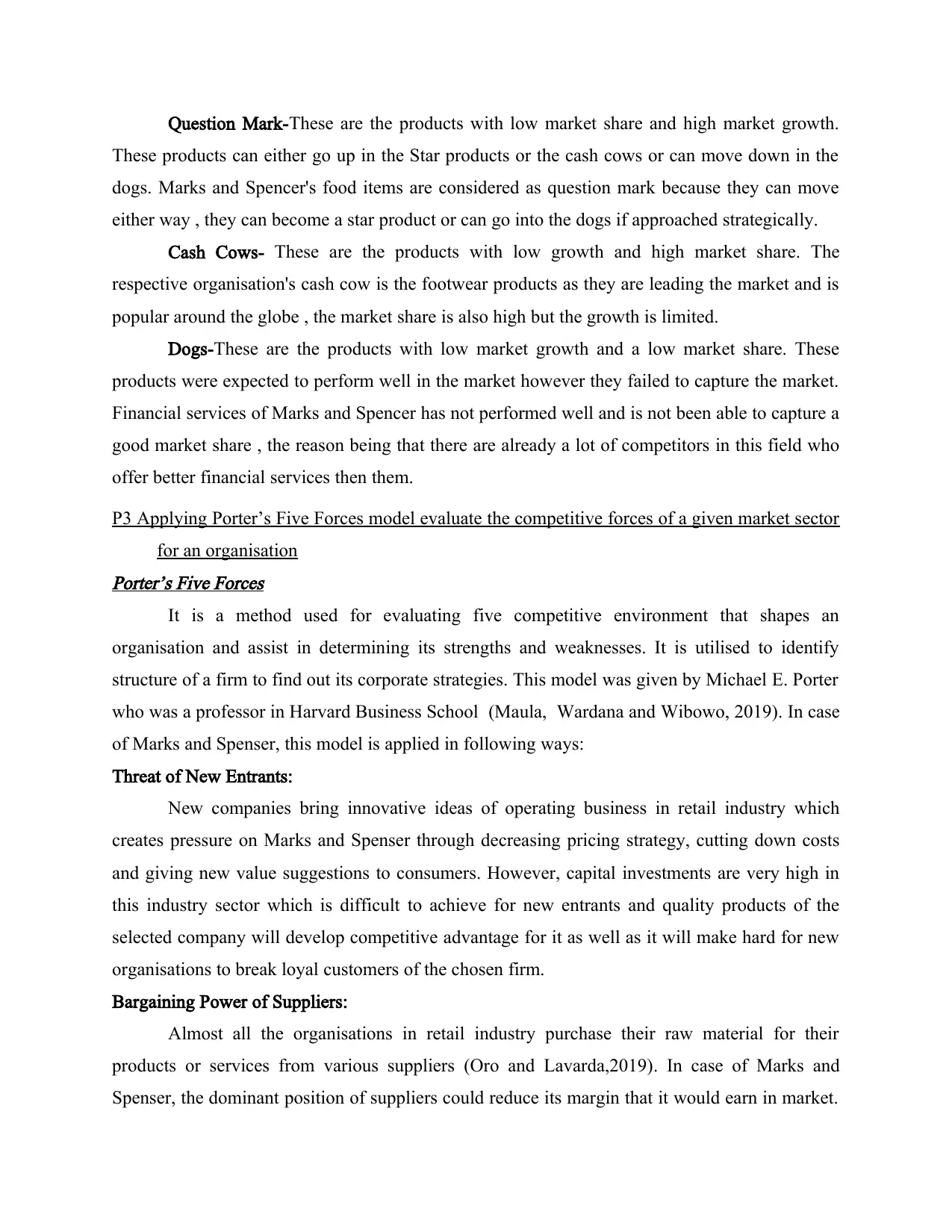
Question Mark-These are the products with low market share and high market growth.
These products can either go up in the Star products or the cash cows or can move down in the
dogs. Marks and Spencer's food items are considered as question mark because they can move
either way , they can become a star product or can go into the dogs if approached strategically.
Cash Cows- These are the products with low growth and high market share. The
respective organisation's cash cow is the footwear products as they are leading the market and is
popular around the globe , the market share is also high but the growth is limited.
Dogs-These are the products with low market growth and a low market share. These
products were expected to perform well in the market however they failed to capture the market.
Financial services of Marks and Spencer has not performed well and is not been able to capture a
good market share , the reason being that there are already a lot of competitors in this field who
offer better financial services then them.
P3 Applying Porter’s Five Forces model evaluate the competitive forces of a given market sector
for an organisationPorter’s Five Forces
It is a method used for evaluating five competitive environment that shapes an
organisation and assist in determining its strengths and weaknesses. It is utilised to identify
structure of a firm to find out its corporate strategies. This model was given by Michael E. Porter
who was a professor in Harvard Business School (Maula, Wardana and Wibowo, 2019). In case
of Marks and Spenser, this model is applied in following ways:
Threat of New Entrants:
New companies bring innovative ideas of operating business in retail industry which
creates pressure on Marks and Spenser through decreasing pricing strategy, cutting down costs
and giving new value suggestions to consumers. However, capital investments are very high in
this industry sector which is difficult to achieve for new entrants and quality products of the
selected company will develop competitive advantage for it as well as it will make hard for new
organisations to break loyal customers of the chosen firm.
Bargaining Power of Suppliers:
Almost all the organisations in retail industry purchase their raw material for their
products or services from various suppliers (Oro and Lavarda,2019). In case of Marks and
Spenser, the dominant position of suppliers could reduce its margin that it would earn in market.
These products can either go up in the Star products or the cash cows or can move down in the
dogs. Marks and Spencer's food items are considered as question mark because they can move
either way , they can become a star product or can go into the dogs if approached strategically.
Cash Cows- These are the products with low growth and high market share. The
respective organisation's cash cow is the footwear products as they are leading the market and is
popular around the globe , the market share is also high but the growth is limited.
Dogs-These are the products with low market growth and a low market share. These
products were expected to perform well in the market however they failed to capture the market.
Financial services of Marks and Spencer has not performed well and is not been able to capture a
good market share , the reason being that there are already a lot of competitors in this field who
offer better financial services then them.
P3 Applying Porter’s Five Forces model evaluate the competitive forces of a given market sector
for an organisationPorter’s Five Forces
It is a method used for evaluating five competitive environment that shapes an
organisation and assist in determining its strengths and weaknesses. It is utilised to identify
structure of a firm to find out its corporate strategies. This model was given by Michael E. Porter
who was a professor in Harvard Business School (Maula, Wardana and Wibowo, 2019). In case
of Marks and Spenser, this model is applied in following ways:
Threat of New Entrants:
New companies bring innovative ideas of operating business in retail industry which
creates pressure on Marks and Spenser through decreasing pricing strategy, cutting down costs
and giving new value suggestions to consumers. However, capital investments are very high in
this industry sector which is difficult to achieve for new entrants and quality products of the
selected company will develop competitive advantage for it as well as it will make hard for new
organisations to break loyal customers of the chosen firm.
Bargaining Power of Suppliers:
Almost all the organisations in retail industry purchase their raw material for their
products or services from various suppliers (Oro and Lavarda,2019). In case of Marks and
Spenser, the dominant position of suppliers could reduce its margin that it would earn in market.
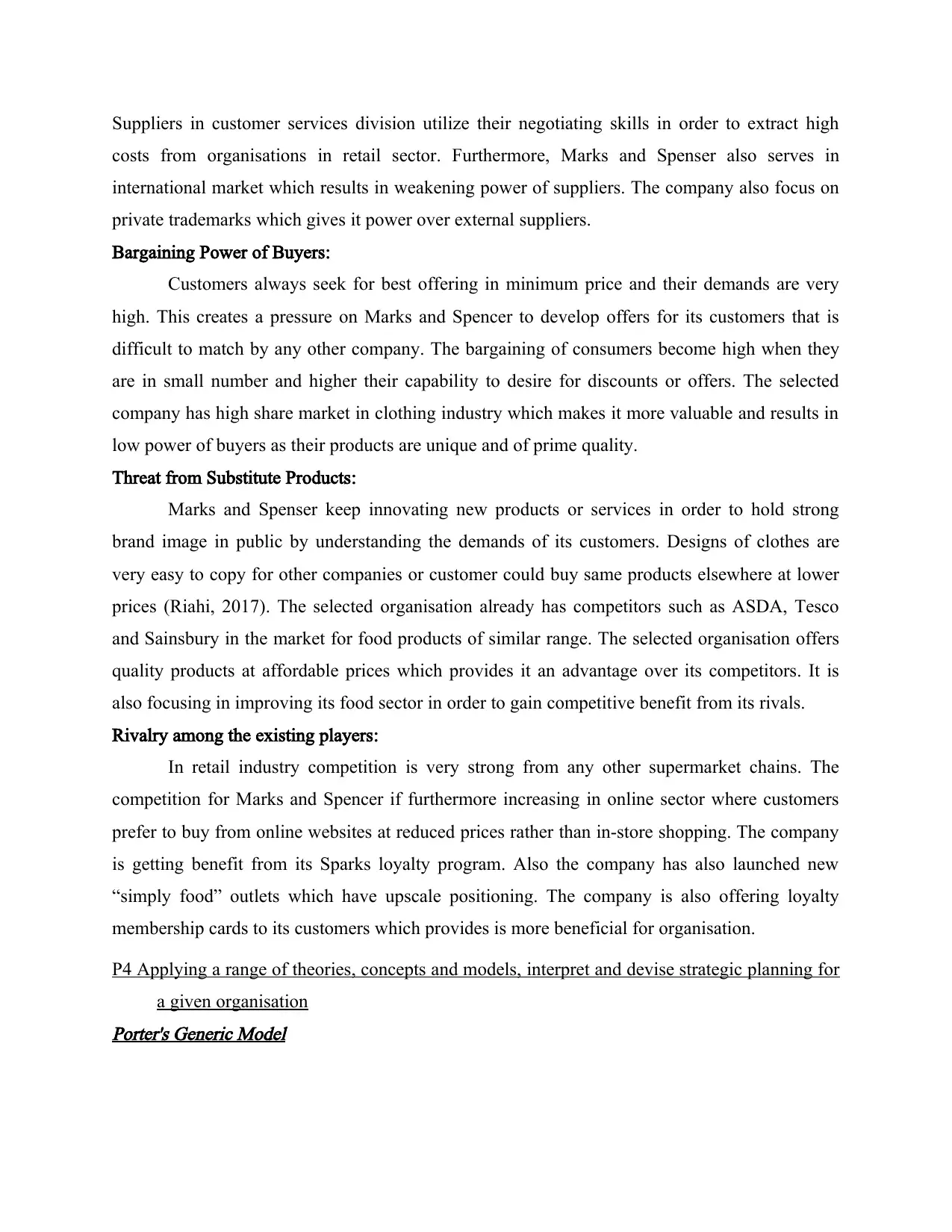
Suppliers in customer services division utilize their negotiating skills in order to extract high
costs from organisations in retail sector. Furthermore, Marks and Spenser also serves in
international market which results in weakening power of suppliers. The company also focus on
private trademarks which gives it power over external suppliers.
Bargaining Power of Buyers:
Customers always seek for best offering in minimum price and their demands are very
high. This creates a pressure on Marks and Spencer to develop offers for its customers that is
difficult to match by any other company. The bargaining of consumers become high when they
are in small number and higher their capability to desire for discounts or offers. The selected
company has high share market in clothing industry which makes it more valuable and results in
low power of buyers as their products are unique and of prime quality.
Threat from Substitute Products:
Marks and Spenser keep innovating new products or services in order to hold strong
brand image in public by understanding the demands of its customers. Designs of clothes are
very easy to copy for other companies or customer could buy same products elsewhere at lower
prices (Riahi, 2017). The selected organisation already has competitors such as ASDA, Tesco
and Sainsbury in the market for food products of similar range. The selected organisation offers
quality products at affordable prices which provides it an advantage over its competitors. It is
also focusing in improving its food sector in order to gain competitive benefit from its rivals.
Rivalry among the existing players:
In retail industry competition is very strong from any other supermarket chains. The
competition for Marks and Spencer if furthermore increasing in online sector where customers
prefer to buy from online websites at reduced prices rather than in-store shopping. The company
is getting benefit from its Sparks loyalty program. Also the company has also launched new
“simply food” outlets which have upscale positioning. The company is also offering loyalty
membership cards to its customers which provides is more beneficial for organisation.
P4 Applying a range of theories, concepts and models, interpret and devise strategic planning for
a given organisationPorter's Generic Model
costs from organisations in retail sector. Furthermore, Marks and Spenser also serves in
international market which results in weakening power of suppliers. The company also focus on
private trademarks which gives it power over external suppliers.
Bargaining Power of Buyers:
Customers always seek for best offering in minimum price and their demands are very
high. This creates a pressure on Marks and Spencer to develop offers for its customers that is
difficult to match by any other company. The bargaining of consumers become high when they
are in small number and higher their capability to desire for discounts or offers. The selected
company has high share market in clothing industry which makes it more valuable and results in
low power of buyers as their products are unique and of prime quality.
Threat from Substitute Products:
Marks and Spenser keep innovating new products or services in order to hold strong
brand image in public by understanding the demands of its customers. Designs of clothes are
very easy to copy for other companies or customer could buy same products elsewhere at lower
prices (Riahi, 2017). The selected organisation already has competitors such as ASDA, Tesco
and Sainsbury in the market for food products of similar range. The selected organisation offers
quality products at affordable prices which provides it an advantage over its competitors. It is
also focusing in improving its food sector in order to gain competitive benefit from its rivals.
Rivalry among the existing players:
In retail industry competition is very strong from any other supermarket chains. The
competition for Marks and Spencer if furthermore increasing in online sector where customers
prefer to buy from online websites at reduced prices rather than in-store shopping. The company
is getting benefit from its Sparks loyalty program. Also the company has also launched new
“simply food” outlets which have upscale positioning. The company is also offering loyalty
membership cards to its customers which provides is more beneficial for organisation.
P4 Applying a range of theories, concepts and models, interpret and devise strategic planning for
a given organisationPorter's Generic Model
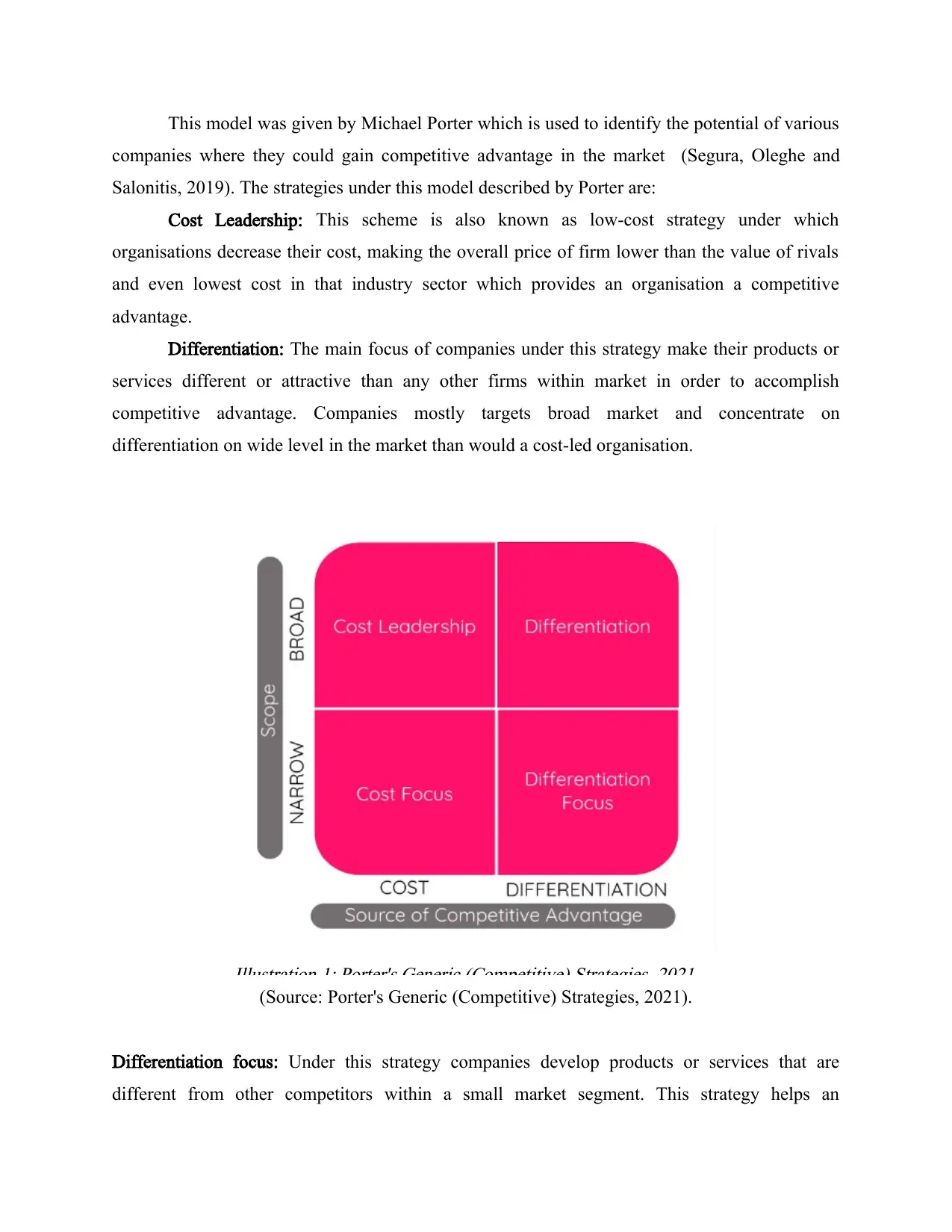
This model was given by Michael Porter which is used to identify the potential of various
companies where they could gain competitive advantage in the market (Segura, Oleghe and
Salonitis, 2019). The strategies under this model described by Porter are:
Cost Leadership: This scheme is also known as low-cost strategy under which
organisations decrease their cost, making the overall price of firm lower than the value of rivals
and even lowest cost in that industry sector which provides an organisation a competitive
advantage.
Differentiation: The main focus of companies under this strategy make their products or
services different or attractive than any other firms within market in order to accomplish
competitive advantage. Companies mostly targets broad market and concentrate on
differentiation on wide level in the market than would a cost-led organisation.
(Source: Porter's Generic (Competitive) Strategies, 2021).
Differentiation focus: Under this strategy companies develop products or services that are
different from other competitors within a small market segment. This strategy helps an
Illustration 1: Porter's Generic (Competitive) Strategies, 2021.
companies where they could gain competitive advantage in the market (Segura, Oleghe and
Salonitis, 2019). The strategies under this model described by Porter are:
Cost Leadership: This scheme is also known as low-cost strategy under which
organisations decrease their cost, making the overall price of firm lower than the value of rivals
and even lowest cost in that industry sector which provides an organisation a competitive
advantage.
Differentiation: The main focus of companies under this strategy make their products or
services different or attractive than any other firms within market in order to accomplish
competitive advantage. Companies mostly targets broad market and concentrate on
differentiation on wide level in the market than would a cost-led organisation.
(Source: Porter's Generic (Competitive) Strategies, 2021).
Differentiation focus: Under this strategy companies develop products or services that are
different from other competitors within a small market segment. This strategy helps an
Illustration 1: Porter's Generic (Competitive) Strategies, 2021.
Secure Best Marks with AI Grader
Need help grading? Try our AI Grader for instant feedback on your assignments.
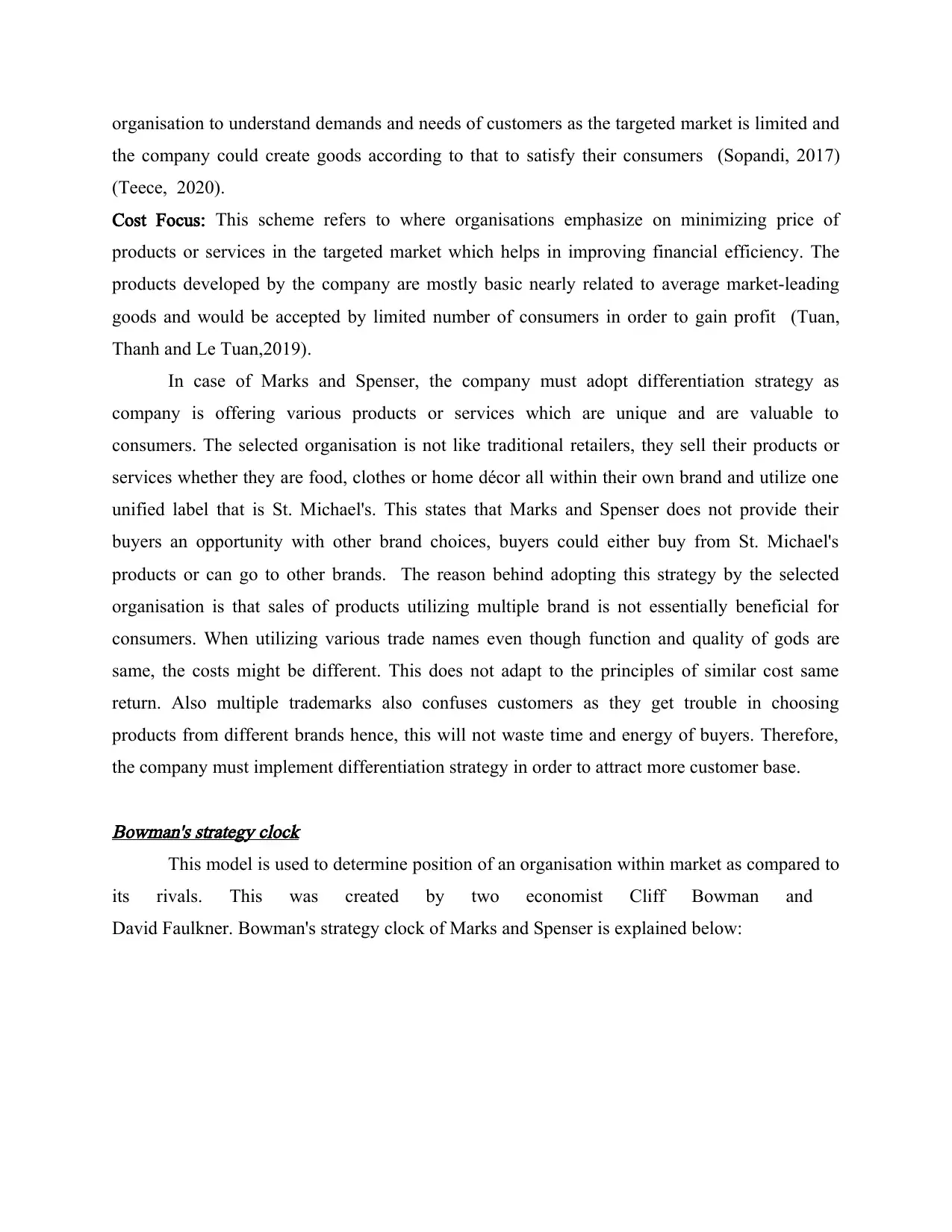
organisation to understand demands and needs of customers as the targeted market is limited and
the company could create goods according to that to satisfy their consumers (Sopandi, 2017)
(Teece, 2020).
Cost Focus: This scheme refers to where organisations emphasize on minimizing price of
products or services in the targeted market which helps in improving financial efficiency. The
products developed by the company are mostly basic nearly related to average market-leading
goods and would be accepted by limited number of consumers in order to gain profit (Tuan,
Thanh and Le Tuan,2019).
In case of Marks and Spenser, the company must adopt differentiation strategy as
company is offering various products or services which are unique and are valuable to
consumers. The selected organisation is not like traditional retailers, they sell their products or
services whether they are food, clothes or home décor all within their own brand and utilize one
unified label that is St. Michael's. This states that Marks and Spenser does not provide their
buyers an opportunity with other brand choices, buyers could either buy from St. Michael's
products or can go to other brands. The reason behind adopting this strategy by the selected
organisation is that sales of products utilizing multiple brand is not essentially beneficial for
consumers. When utilizing various trade names even though function and quality of gods are
same, the costs might be different. This does not adapt to the principles of similar cost same
return. Also multiple trademarks also confuses customers as they get trouble in choosing
products from different brands hence, this will not waste time and energy of buyers. Therefore,
the company must implement differentiation strategy in order to attract more customer base.
Bowman's strategy clock
This model is used to determine position of an organisation within market as compared to
its rivals. This was created by two economist Cliff Bowman and
David Faulkner. Bowman's strategy clock of Marks and Spenser is explained below:
the company could create goods according to that to satisfy their consumers (Sopandi, 2017)
(Teece, 2020).
Cost Focus: This scheme refers to where organisations emphasize on minimizing price of
products or services in the targeted market which helps in improving financial efficiency. The
products developed by the company are mostly basic nearly related to average market-leading
goods and would be accepted by limited number of consumers in order to gain profit (Tuan,
Thanh and Le Tuan,2019).
In case of Marks and Spenser, the company must adopt differentiation strategy as
company is offering various products or services which are unique and are valuable to
consumers. The selected organisation is not like traditional retailers, they sell their products or
services whether they are food, clothes or home décor all within their own brand and utilize one
unified label that is St. Michael's. This states that Marks and Spenser does not provide their
buyers an opportunity with other brand choices, buyers could either buy from St. Michael's
products or can go to other brands. The reason behind adopting this strategy by the selected
organisation is that sales of products utilizing multiple brand is not essentially beneficial for
consumers. When utilizing various trade names even though function and quality of gods are
same, the costs might be different. This does not adapt to the principles of similar cost same
return. Also multiple trademarks also confuses customers as they get trouble in choosing
products from different brands hence, this will not waste time and energy of buyers. Therefore,
the company must implement differentiation strategy in order to attract more customer base.
Bowman's strategy clock
This model is used to determine position of an organisation within market as compared to
its rivals. This was created by two economist Cliff Bowman and
David Faulkner. Bowman's strategy clock of Marks and Spenser is explained below:
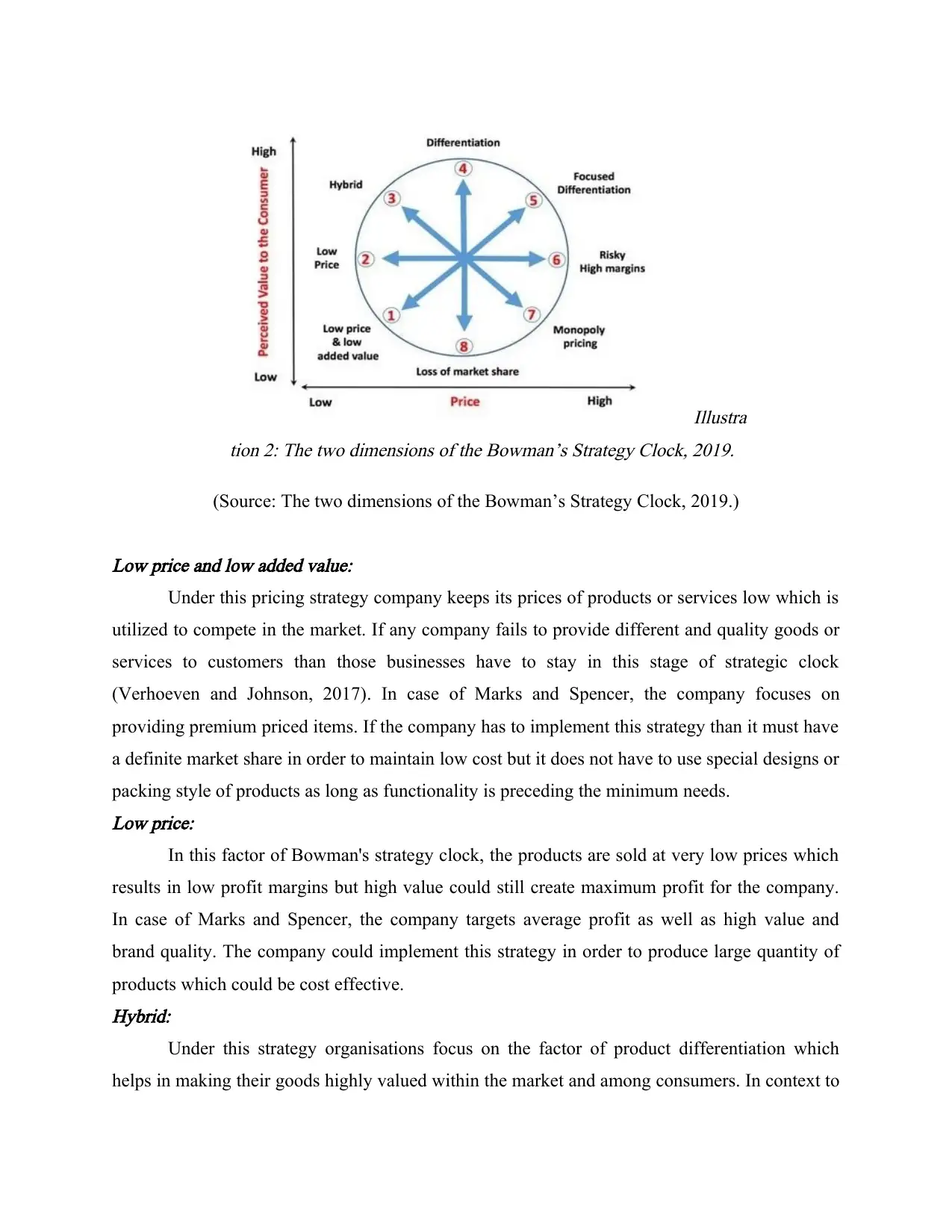
(Source: The two dimensions of the Bowman’s Strategy Clock, 2019.)
Low price and low added value:
Under this pricing strategy company keeps its prices of products or services low which is
utilized to compete in the market. If any company fails to provide different and quality goods or
services to customers than those businesses have to stay in this stage of strategic clock
(Verhoeven and Johnson, 2017). In case of Marks and Spencer, the company focuses on
providing premium priced items. If the company has to implement this strategy than it must have
a definite market share in order to maintain low cost but it does not have to use special designs or
packing style of products as long as functionality is preceding the minimum needs.Low price:
In this factor of Bowman's strategy clock, the products are sold at very low prices which
results in low profit margins but high value could still create maximum profit for the company.
In case of Marks and Spencer, the company targets average profit as well as high value and
brand quality. The company could implement this strategy in order to produce large quantity of
products which could be cost effective.Hybrid:
Under this strategy organisations focus on the factor of product differentiation which
helps in making their goods highly valued within the market and among consumers. In context to
Illustra
tion 2: The two dimensions of the Bowman’s Strategy Clock, 2019.
Low price and low added value:
Under this pricing strategy company keeps its prices of products or services low which is
utilized to compete in the market. If any company fails to provide different and quality goods or
services to customers than those businesses have to stay in this stage of strategic clock
(Verhoeven and Johnson, 2017). In case of Marks and Spencer, the company focuses on
providing premium priced items. If the company has to implement this strategy than it must have
a definite market share in order to maintain low cost but it does not have to use special designs or
packing style of products as long as functionality is preceding the minimum needs.Low price:
In this factor of Bowman's strategy clock, the products are sold at very low prices which
results in low profit margins but high value could still create maximum profit for the company.
In case of Marks and Spencer, the company targets average profit as well as high value and
brand quality. The company could implement this strategy in order to produce large quantity of
products which could be cost effective.Hybrid:
Under this strategy organisations focus on the factor of product differentiation which
helps in making their goods highly valued within the market and among consumers. In context to
Illustra
tion 2: The two dimensions of the Bowman’s Strategy Clock, 2019.

Marks and Spenser, the company could provide medium to high value products at low prices.
This could help the company in creating strong brand image which will attract more customer
base.Differentiation:
This factor of strategy clock provides firms opting for differentiation scheme under which
organisations try to offer high quality product at average prices and offer their consumers highest
level of detected value that makes them distinguished from others in the marketplace (Williams
Jr and et. al., 2018). In relation to Marks and Spencer, the company must focus on making its
products or services different from its competitors. The selected company accomplished
differentiation by launching Per Una designer cloths and increased lingerie for women, kids and
men wear.Focused differentiation:
This factor mainly focuses on luxury and exclusive goods or services that are of high
quality and are sold at very high prices to attain maximum profit margins. In case of Marks and
Spencer, the company have diverse features for its products and are specially designed which are
not available at any other departmental shops (Bourguignon and Floquet,2019). The company
implements this differentiation strategy not only their goods or services but also in terms of
quality and brand culture.Risky high margins:
This strategy is enforced by companies in order to charge higher prices for goods that are
recognized as ordinary in value by the buyers. This strategy is considered to be very risky to
implement as because of this position of firms is most likely to fail in long period of time.Monopoly pricing:
Under this strategy organisations place themselves as monopoly leader within
marketplace as they are the only firms offering particular kind of product or services in market
which eventually results in no competition and they will be the only one deciding cost of that
specific product (Caner and Bhatti, 2020).Loss of market share:
This strategy explains that companies have not able to provide product or services that
provides value to consumers. The organisations under this segment implement standard costs on
This could help the company in creating strong brand image which will attract more customer
base.Differentiation:
This factor of strategy clock provides firms opting for differentiation scheme under which
organisations try to offer high quality product at average prices and offer their consumers highest
level of detected value that makes them distinguished from others in the marketplace (Williams
Jr and et. al., 2018). In relation to Marks and Spencer, the company must focus on making its
products or services different from its competitors. The selected company accomplished
differentiation by launching Per Una designer cloths and increased lingerie for women, kids and
men wear.Focused differentiation:
This factor mainly focuses on luxury and exclusive goods or services that are of high
quality and are sold at very high prices to attain maximum profit margins. In case of Marks and
Spencer, the company have diverse features for its products and are specially designed which are
not available at any other departmental shops (Bourguignon and Floquet,2019). The company
implements this differentiation strategy not only their goods or services but also in terms of
quality and brand culture.Risky high margins:
This strategy is enforced by companies in order to charge higher prices for goods that are
recognized as ordinary in value by the buyers. This strategy is considered to be very risky to
implement as because of this position of firms is most likely to fail in long period of time.Monopoly pricing:
Under this strategy organisations place themselves as monopoly leader within
marketplace as they are the only firms offering particular kind of product or services in market
which eventually results in no competition and they will be the only one deciding cost of that
specific product (Caner and Bhatti, 2020).Loss of market share:
This strategy explains that companies have not able to provide product or services that
provides value to consumers. The organisations under this segment implement standard costs on
Paraphrase This Document
Need a fresh take? Get an instant paraphrase of this document with our AI Paraphraser

their goods or services to stay applicable and competitive within market as well as among
consumers.Business plan
Company's summary:
Marks and Spencer was founded in the year 1884 by Michael Marks and Thomas Spencer
in Leeds. The company has its headquarter in London, England and approximately 959 stores in
entire UK. It is a major multinational retailer company in UK which deals in home products,
cloths and food products (Farha, 2016).
Mission:
The main motive of the company is to make quality products or services for customers
which are accessible by them easily.
Vision:
The vision of the company is to give a standard against which its rivals might be
evaluated, from consumer experience, to care for people as well as environment and to keep the
work-place environment for workers.
Strategic Objectives:
Marks and Spencer objective is to provide stakeholder value in terms of enhanced returns
but also in related to increase sales and market share in retail industry. The company utilize
differentiation strategy by providing innovation, quality and freshness in their products or
services to their customers (Gattorna,2017).
Tactics:
The company uses competitive pricing strategy in its marketing mix for its goods. The
company has its own brand for women, kids and men clothing. The company provides premium
quality products that are priced between medium to high.
Monitoring and Controlling:
The company monitors its product prices, cost of manufacturing, demand of products or
services continuously in order to gain advantage against its competitors. The organisation also
controls positioning and repositioning of goods or services in order to generate more sales
(Glauner, 2016). The firm always keeps monitoring the market changes and trends to modify its
strategies according to them.
consumers.Business plan
Company's summary:
Marks and Spencer was founded in the year 1884 by Michael Marks and Thomas Spencer
in Leeds. The company has its headquarter in London, England and approximately 959 stores in
entire UK. It is a major multinational retailer company in UK which deals in home products,
cloths and food products (Farha, 2016).
Mission:
The main motive of the company is to make quality products or services for customers
which are accessible by them easily.
Vision:
The vision of the company is to give a standard against which its rivals might be
evaluated, from consumer experience, to care for people as well as environment and to keep the
work-place environment for workers.
Strategic Objectives:
Marks and Spencer objective is to provide stakeholder value in terms of enhanced returns
but also in related to increase sales and market share in retail industry. The company utilize
differentiation strategy by providing innovation, quality and freshness in their products or
services to their customers (Gattorna,2017).
Tactics:
The company uses competitive pricing strategy in its marketing mix for its goods. The
company has its own brand for women, kids and men clothing. The company provides premium
quality products that are priced between medium to high.
Monitoring and Controlling:
The company monitors its product prices, cost of manufacturing, demand of products or
services continuously in order to gain advantage against its competitors. The organisation also
controls positioning and repositioning of goods or services in order to generate more sales
(Glauner, 2016). The firm always keeps monitoring the market changes and trends to modify its
strategies according to them.
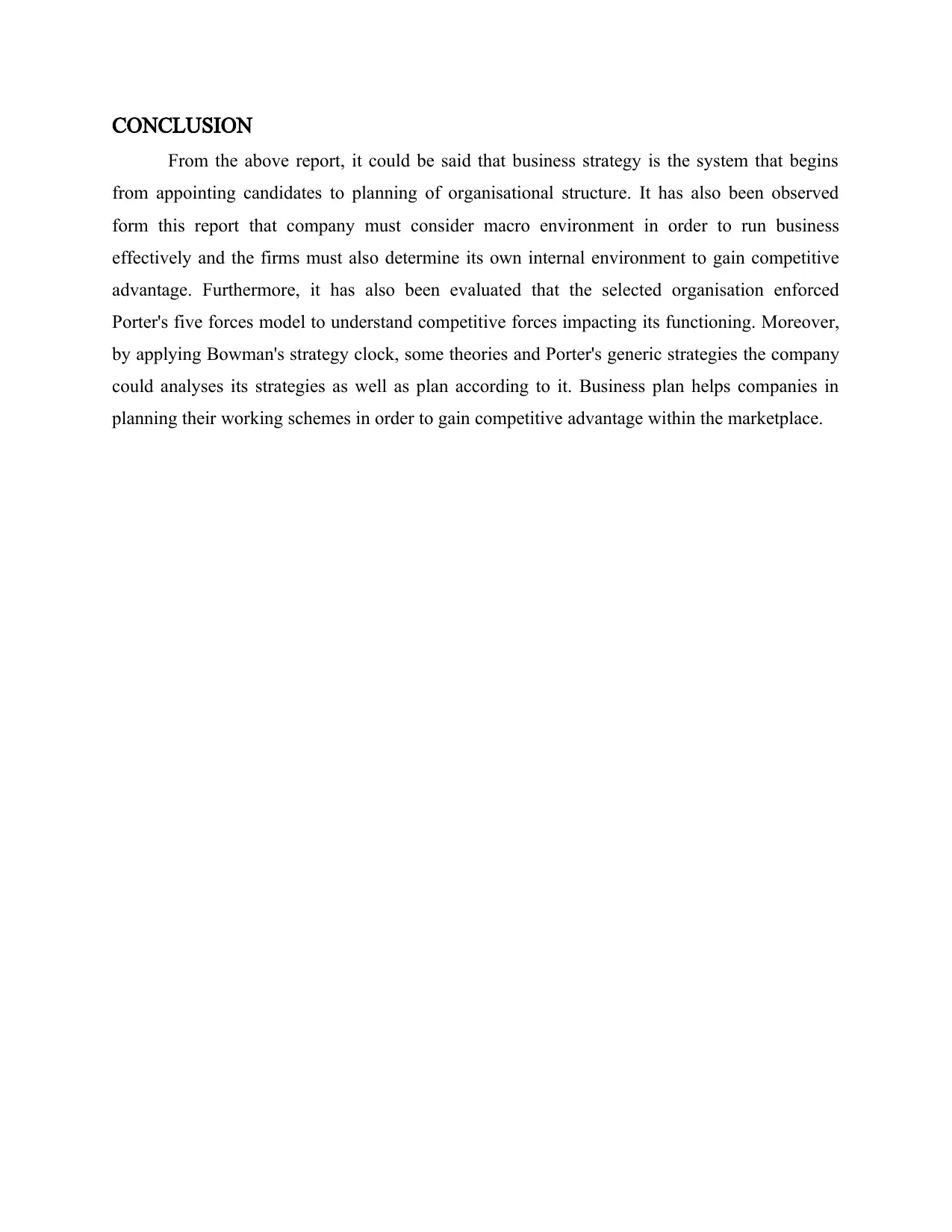
CONCLUSION
From the above report, it could be said that business strategy is the system that begins
from appointing candidates to planning of organisational structure. It has also been observed
form this report that company must consider macro environment in order to run business
effectively and the firms must also determine its own internal environment to gain competitive
advantage. Furthermore, it has also been evaluated that the selected organisation enforced
Porter's five forces model to understand competitive forces impacting its functioning. Moreover,
by applying Bowman's strategy clock, some theories and Porter's generic strategies the company
could analyses its strategies as well as plan according to it. Business plan helps companies in
planning their working schemes in order to gain competitive advantage within the marketplace.
From the above report, it could be said that business strategy is the system that begins
from appointing candidates to planning of organisational structure. It has also been observed
form this report that company must consider macro environment in order to run business
effectively and the firms must also determine its own internal environment to gain competitive
advantage. Furthermore, it has also been evaluated that the selected organisation enforced
Porter's five forces model to understand competitive forces impacting its functioning. Moreover,
by applying Bowman's strategy clock, some theories and Porter's generic strategies the company
could analyses its strategies as well as plan according to it. Business plan helps companies in
planning their working schemes in order to gain competitive advantage within the marketplace.
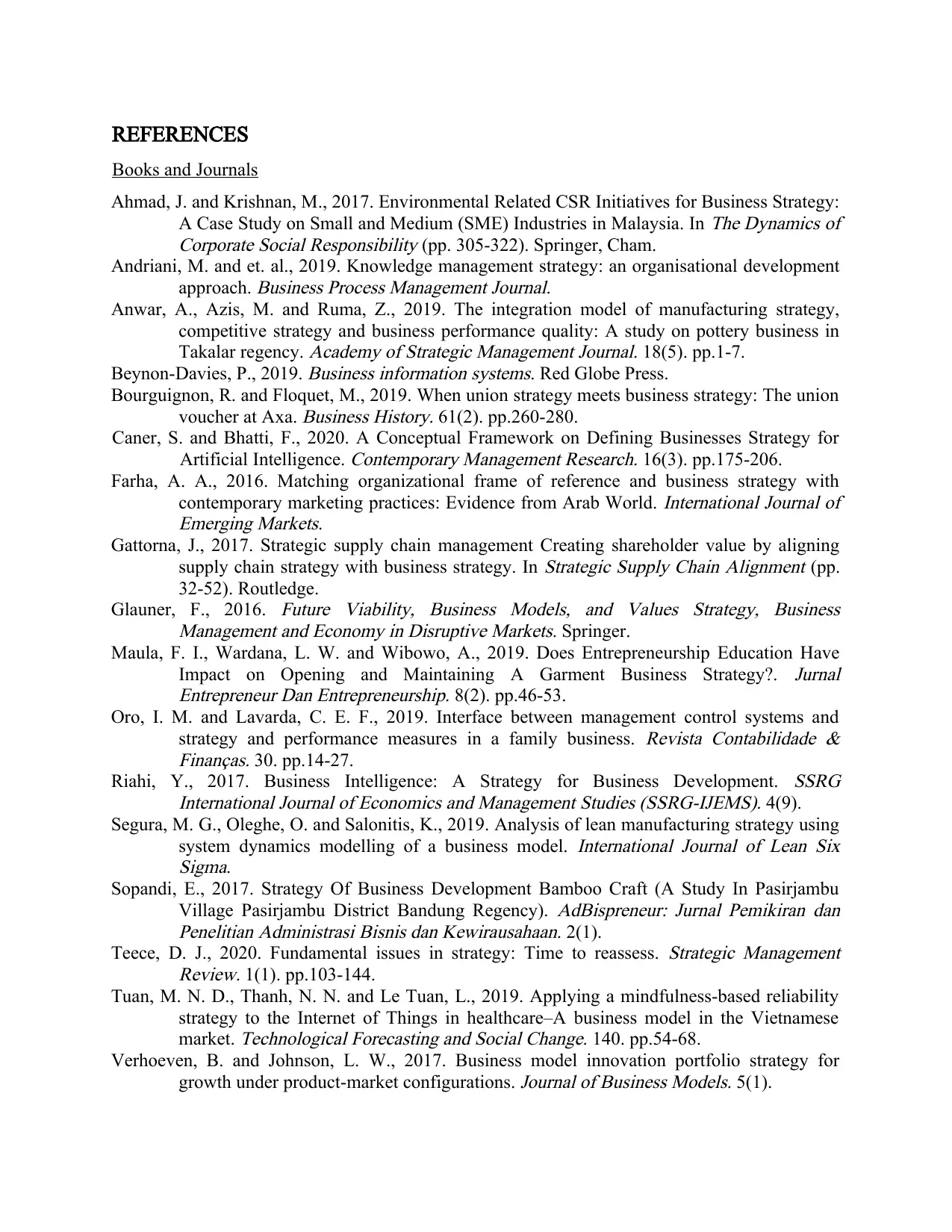
REFERENCES
Books and Journals
Ahmad, J. and Krishnan, M., 2017. Environmental Related CSR Initiatives for Business Strategy:
A Case Study on Small and Medium (SME) Industries in Malaysia. In
The Dynamics of
Corporate Social Responsibility (pp. 305-322). Springer, Cham.
Andriani, M. and et. al., 2019. Knowledge management strategy: an organisational development
approach.
Business Process Management Journal.
Anwar, A., Azis, M. and Ruma, Z., 2019. The integration model of manufacturing strategy,
competitive strategy and business performance quality: A study on pottery business in
Takalar regency.
Academy of Strategic Management Journal. 18(5). pp.1-7.
Beynon-Davies, P., 2019.
Business information systems. Red Globe Press.
Bourguignon, R. and Floquet, M., 2019. When union strategy meets business strategy: The union
voucher at Axa.
Business History. 61(2). pp.260-280.
Caner, S. and Bhatti, F., 2020. A Conceptual Framework on Defining Businesses Strategy for
Artificial Intelligence.
Contemporary Management Research. 16(3). pp.175-206.
Farha, A. A., 2016. Matching organizational frame of reference and business strategy with
contemporary marketing practices: Evidence from Arab World.
International Journal of
Emerging Markets.
Gattorna, J., 2017. Strategic supply chain management Creating shareholder value by aligning
supply chain strategy with business strategy. In
Strategic Supply Chain Alignment (pp.
32-52). Routledge.
Glauner, F., 2016.
Future Viability, Business Models, and Values Strategy, Business
Management and Economy in Disruptive Markets. Springer.
Maula, F. I., Wardana, L. W. and Wibowo, A., 2019. Does Entrepreneurship Education Have
Impact on Opening and Maintaining A Garment Business Strategy?.
Jurnal
Entrepreneur Dan Entrepreneurship. 8(2). pp.46-53.
Oro, I. M. and Lavarda, C. E. F., 2019. Interface between management control systems and
strategy and performance measures in a family business.
Revista Contabilidade &
Finanças. 30. pp.14-27.
Riahi, Y., 2017. Business Intelligence: A Strategy for Business Development.
SSRG
International Journal of Economics and Management Studies (SSRG-IJEMS). 4(9).
Segura, M. G., Oleghe, O. and Salonitis, K., 2019. Analysis of lean manufacturing strategy using
system dynamics modelling of a business model.
International Journal of Lean Six
Sigma.
Sopandi, E., 2017. Strategy Of Business Development Bamboo Craft (A Study In Pasirjambu
Village Pasirjambu District Bandung Regency).
AdBispreneur: Jurnal Pemikiran dan
Penelitian Administrasi Bisnis dan Kewirausahaan. 2(1).
Teece, D. J., 2020. Fundamental issues in strategy: Time to reassess.
Strategic Management
Review. 1(1). pp.103-144.
Tuan, M. N. D., Thanh, N. N. and Le Tuan, L., 2019. Applying a mindfulness-based reliability
strategy to the Internet of Things in healthcare–A business model in the Vietnamese
market.
Technological Forecasting and Social Change. 140. pp.54-68.
Verhoeven, B. and Johnson, L. W., 2017. Business model innovation portfolio strategy for
growth under product-market configurations.
Journal of Business Models. 5(1).
Books and Journals
Ahmad, J. and Krishnan, M., 2017. Environmental Related CSR Initiatives for Business Strategy:
A Case Study on Small and Medium (SME) Industries in Malaysia. In
The Dynamics of
Corporate Social Responsibility (pp. 305-322). Springer, Cham.
Andriani, M. and et. al., 2019. Knowledge management strategy: an organisational development
approach.
Business Process Management Journal.
Anwar, A., Azis, M. and Ruma, Z., 2019. The integration model of manufacturing strategy,
competitive strategy and business performance quality: A study on pottery business in
Takalar regency.
Academy of Strategic Management Journal. 18(5). pp.1-7.
Beynon-Davies, P., 2019.
Business information systems. Red Globe Press.
Bourguignon, R. and Floquet, M., 2019. When union strategy meets business strategy: The union
voucher at Axa.
Business History. 61(2). pp.260-280.
Caner, S. and Bhatti, F., 2020. A Conceptual Framework on Defining Businesses Strategy for
Artificial Intelligence.
Contemporary Management Research. 16(3). pp.175-206.
Farha, A. A., 2016. Matching organizational frame of reference and business strategy with
contemporary marketing practices: Evidence from Arab World.
International Journal of
Emerging Markets.
Gattorna, J., 2017. Strategic supply chain management Creating shareholder value by aligning
supply chain strategy with business strategy. In
Strategic Supply Chain Alignment (pp.
32-52). Routledge.
Glauner, F., 2016.
Future Viability, Business Models, and Values Strategy, Business
Management and Economy in Disruptive Markets. Springer.
Maula, F. I., Wardana, L. W. and Wibowo, A., 2019. Does Entrepreneurship Education Have
Impact on Opening and Maintaining A Garment Business Strategy?.
Jurnal
Entrepreneur Dan Entrepreneurship. 8(2). pp.46-53.
Oro, I. M. and Lavarda, C. E. F., 2019. Interface between management control systems and
strategy and performance measures in a family business.
Revista Contabilidade &
Finanças. 30. pp.14-27.
Riahi, Y., 2017. Business Intelligence: A Strategy for Business Development.
SSRG
International Journal of Economics and Management Studies (SSRG-IJEMS). 4(9).
Segura, M. G., Oleghe, O. and Salonitis, K., 2019. Analysis of lean manufacturing strategy using
system dynamics modelling of a business model.
International Journal of Lean Six
Sigma.
Sopandi, E., 2017. Strategy Of Business Development Bamboo Craft (A Study In Pasirjambu
Village Pasirjambu District Bandung Regency).
AdBispreneur: Jurnal Pemikiran dan
Penelitian Administrasi Bisnis dan Kewirausahaan. 2(1).
Teece, D. J., 2020. Fundamental issues in strategy: Time to reassess.
Strategic Management
Review. 1(1). pp.103-144.
Tuan, M. N. D., Thanh, N. N. and Le Tuan, L., 2019. Applying a mindfulness-based reliability
strategy to the Internet of Things in healthcare–A business model in the Vietnamese
market.
Technological Forecasting and Social Change. 140. pp.54-68.
Verhoeven, B. and Johnson, L. W., 2017. Business model innovation portfolio strategy for
growth under product-market configurations.
Journal of Business Models. 5(1).
Secure Best Marks with AI Grader
Need help grading? Try our AI Grader for instant feedback on your assignments.
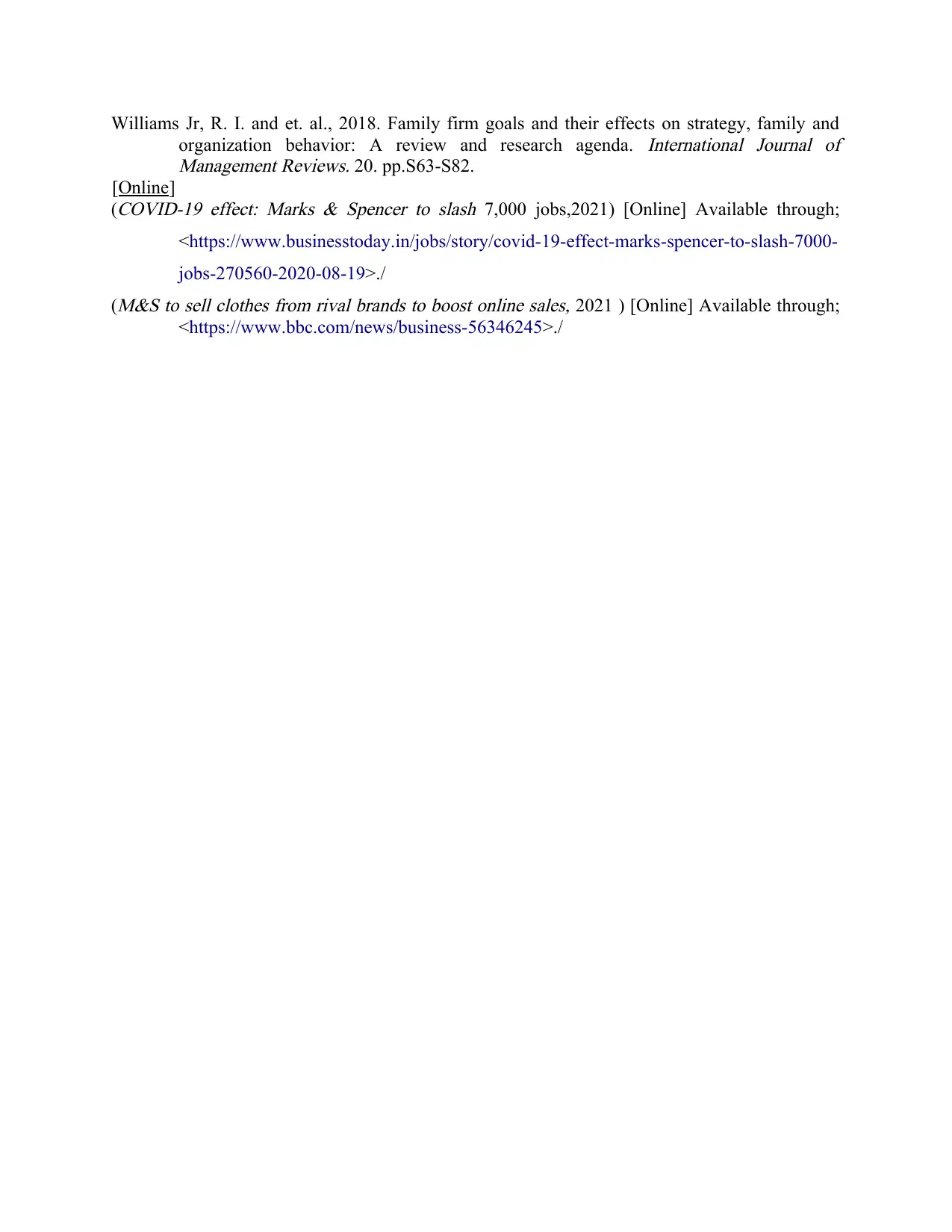
Williams Jr, R. I. and et. al., 2018. Family firm goals and their effects on strategy, family and
organization behavior: A review and research agenda.
International Journal of
Management Reviews. 20. pp.S63-S82.
[Online]
(
COVID-19 effect: Marks & Spencer to slash 7,000 jobs,2021) [Online] Available through;
<https://www.businesstoday.in/jobs/story/covid-19-effect-marks-spencer-to-slash-7000-
jobs-270560-2020-08-19>./
(
M&S to sell clothes from rival brands to boost online sales, 2021 ) [Online] Available through;
<https://www.bbc.com/news/business-56346245>./
organization behavior: A review and research agenda.
International Journal of
Management Reviews. 20. pp.S63-S82.
[Online]
(
COVID-19 effect: Marks & Spencer to slash 7,000 jobs,2021) [Online] Available through;
<https://www.businesstoday.in/jobs/story/covid-19-effect-marks-spencer-to-slash-7000-
jobs-270560-2020-08-19>./
(
M&S to sell clothes from rival brands to boost online sales, 2021 ) [Online] Available through;
<https://www.bbc.com/news/business-56346245>./
1 out of 17
Related Documents
Your All-in-One AI-Powered Toolkit for Academic Success.
+13062052269
info@desklib.com
Available 24*7 on WhatsApp / Email
![[object Object]](/_next/static/media/star-bottom.7253800d.svg)
Unlock your academic potential
© 2024 | Zucol Services PVT LTD | All rights reserved.




